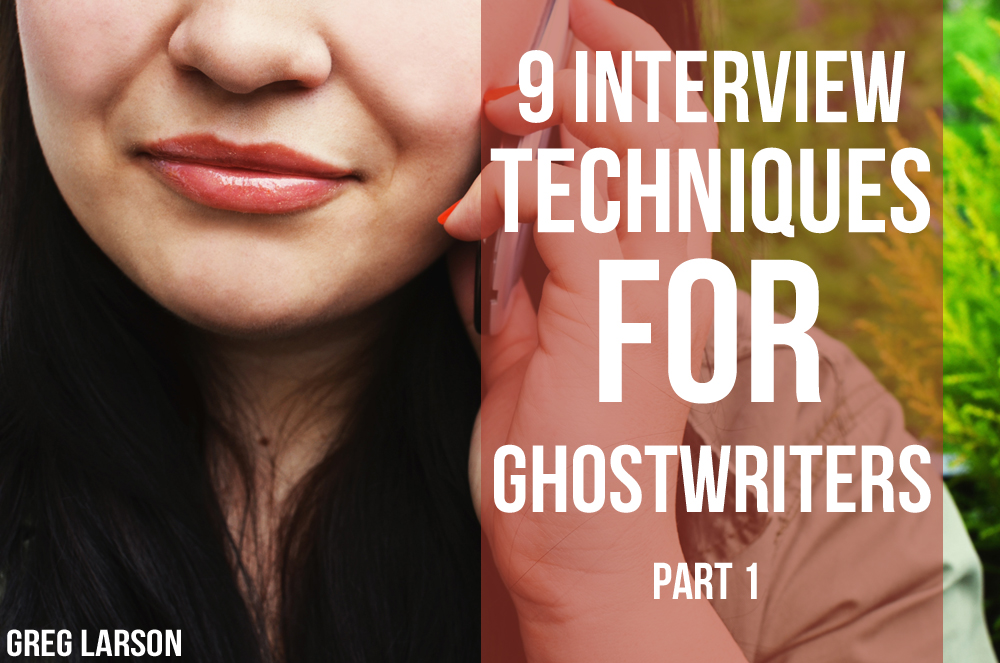My buddy Matt is one hell of a writer. He creates vivid scenes, he renders complex characters, and he can write dialogue with the best of ‘em.
But the man is a wreck on the phone. He struggles ordering pizza without several dozen ums, ahs, and y’knows. No disrespect to him—he happens to be a socially anxious writer, just like me…and probably just like you, too.
I either hide from my anxiety in the Domino’s app, or spend 37 minutes preparing for the conversation when I call a good pizza place—there is no in between.
For a long time, Matt escaped from this problem behind his keyboard. I’m a writer, he told himself, so what if I suck on the phone?
This rationalization worked as well as any other avoidance behavior. He continued working hard as a writer, but he still struggled to make a living. Without decent interview skills, he only took nickel & dime projects.
Thankfully, Matt is getting into ghostwriting now, which means two things:
He can make way more money than before.
He absolutely must get on the phone to sell his services and interview his clients for their books.
Realizing this, he came to me for advice.
“You get people to open up easily. What conversational techniques do you use?”
Bless his heart. Matt assumed there was some magic formula he could employ to make him a better conversationalist.
I said, “Man, it’s gonna sound like a copout, but the only thing that matters is genuine curiosity. That’s it. If you’re curious about the other person and what makes them tick, that’s 80% of getting amazing interviews.”
He looked at me like I’d just answered his question with “Because I said so!”
I continued on. “Okay, dude, look—I do have some techniques I can teach you, but they’re all gonna be worthless if you’re not genuinely curious.”
His eyes lit up and he cocked his eyebrow. I guess I had his curiosity.
So before we continue, I’ll give you the same warning I gave Matt:
I can lay out these techniques I’ve learned after thousands of hours of interviews with hundreds of ghostwriting clients, but they won’t mean a damn thing if you don’t actually give a shit about the other person.
And one more thing: without genuine curiosity, you’ll be so focused on your own anxiety during the interview that you’ll barely get any good material.
Got it?
Okay, cool. Let’s dig in.
1. Find Out What They had for Breakfast
Interviews are nothing more than conversations, and you should treat them as such.
However, some of your clients will have certain assumptions when they get on the phone with you. They’ll think they have to be a polished version of themselves, or that they have to speak in perfect prose (you’re writing a book after all), or that the interview will be a series of their one-sided responses to your pre-planned questions.
All that isn’t completely wrong, per se, but it’s not exactly right, either.
You want your author to treat the call with a small measure of reverence—so you get the most out of the call—but you also want them relaxed. If they’re not comfortable, they won’t open up. Simple as that. If they don’t open up, their book will feel as stilted and distant as your conversations.
The solution? Find out what they had for breakfast.
Seriously, at the beginning of my first interview with someone, I ask them straight up:
“What did you eat for breakfast?”
I learned about this technique from my buddy Charlie.
I was complaining to him about some of my interviews feeling dry at the time.
“How are you warming them up?” he said.
I scoffed. “Warming up? Man, these people are busy. They don’t have time for that. We just dig right in.”
“There’s your answer. Authors are nervous when they get on the phone. Starting your conversation without warming up is like trying to start an engine without a sparkplug. Without the early spark, theres’s nothing to ignite the fuel to get moving.”
He went on to explain his warmup technique:
Asking people what they ate for breakfast not only gets them talking about themselves, but it also gives you insight into who they are—what a person eats for breakfast says a lot about them.
Did they eat alone or with their kids?
Did they have Pop-Tarts or Greek yogurt?
Or did they skip it entirely because they were so nervous for your call?
You find out about their family, their health habits, and maybe even their anxiety levels.
When you get that valuable information, make a note of it for future reference, and reciprocate with a bit about your own morning. You’ll be amazed at how quickly you connect with people based on this conversation thread alone.
When to Use This Technique:
At the beginning of your very first interview call.
To Warm Up for Subsequent Interviews
If you ask a person what they ate for breakfast one time, it’s fun, playful, and gets them loose.
If you ask them what they ate for breakfast on every call, they’ll wonder if you’re planning to poison their cinnamon raisin bagel.
Keep it up and your clients will think you’re hoarding vials of nightshade like a cartoon pirate.
Therefore, to warm up for your second interview, review your notes from the first call. Start by asking about something specific that came up—maybe their son had a soccer game, or they had a weekend trip with their husband.
Anything is fair game (as long as you’re genuinely curious about it) and will show your author that you’re listening beyond the confines of the book.
Note:
Some people need this type of warmup, and some people don’t.
In my experience, the professional speaker types (people who spend a ton of time reciting polished speeches onstage in front of thousands) prefer to dig right in.
Fitness gurus, some sales experts, and generally anxious people will want to warmup. With these people, you’ll actually have to set boundaries to keep them from escaping their anxiety in small talk.
2. Show Them That You’re Teammates—Even If You’re Rivals
She was totally unsure about me. I could hear the hesitation in her voice on our consultation call, and I never expected her to sign with me. I even suggested other ghostwriters who I thought would be better fits for her.
But lo and behold, she signed our agreement.
She was a regular on Fox News, and I was familiar enough with her show to realize that we had very different viewpoints, and those viewpoints would be at the core of her book. Whatever—that wasn’t a problem for me. The real problem was that she seemed sold on my skills, but not completely sold on me as a person.
I had to take action before her apprehension negatively manifested in the project.
On our first interview call, I let her know that we were on the same team, and I wouldn’t project my own views onto her book. I’d be true to her voice and nobody else’s.
I said, “I’m excited to partner with you on your book for several reasons, but the biggest is that it appeals to my libertarian ideals.”
I could hear her smiling on the phone. “Really?” she said. “That’s such a relief to hear.” She completely cracked open. From that moment forward, we had an easy rapport that led to an amazing book, which eventually sold to a Big 5 publisher.
Her stories and her life lessons were the same no matter what relationship we had, but if we hadn’t gotten over that idealogical apprehension from the outset, her book wouldn’t have become nearly as successful as it was.
To sum up:
Tell your author what you find attractive about their project.
Why does every stock photo of shaking hands look like a cheesy ‘80s after-school special about tolerance?
Now, before we move on, it’s important to point out a couple things:
Do not lie! I was careful about my wording, because there was plenty in the book that seemed way outside of my beliefs, but I made it clear that parts of her life lessons and stories appealed to a specific part of my beliefs.
This is not your soapbox to virtue signal! Simply ask yourself, “What common ground—no matter how small—do I share with this seemingly different person?” Once you identify that commonality, call attention to it. Simple. Show the other person that you “get” what they’re trying to do, and move on.
When to Use This Technique:
With everyone, but especially with people who are hesitant to work with you, or are writing a book that doesn’t perfectly line up with your personal experiences or beliefs.
3. The “Put Me in That Moment” Technique
Most people think details in stories are boring.
For the most part, they’re right—but only because they focus on the wrong details.
You know that friend who tells the longest stories with the weakest punch lines? He spends half the time asking himself, “Wait, was that on Thursday or Friday?” or, “Oh crap, what was that cashier’s name again?”
NOBODY GIVES A SHIT—JUST GET TO THE GOOD STUFF!
How much funnier, more powerful, and just plain better would those stories be if they were shorter and focused on the right details?
The problem is that most people tell stories through the lens of what is important to them.
As a ghostwriter, your goal is to hear everything your client tells you through the lens of what is important to the reader.
Why those lenses are at odds:
Your client is telling you a story about being fired from their own company by the board of directors. It’s tragic, painful, and full of conflicting emotions.
But as they tell the story, they’re hiding from all of the juicy stuff:
“That actually happened in 2013, just 5 years after we’d started the company. Henry was the chairman at the time—or wait, was it Bill? I can’t remember; I’ll have to get back to you on that. But anyway, they put this CEO from an Australian firm in my old position and…”
Those details are important to the author, and a few of those tidbits may make it into the book, but the author is skipping over the important stuff. They’re leaving out the salient details that make this a fascinating story you can write in-scene.
So you say:
“We’ll get the names and dates later. Put me in that moment in the board room. What exactly did they say to you?”
Odds are, if it was an emotionally-charged event, they will remember down to the word what everyone said. If not, they can at least remember how it felt, which is a hell of a lot better than knowing the name of the chairman of the board.
This is your reader when you focus on the wrong details. Spoiler alert: underneath those sunglasses, he’s dead. Cause of death: boredom.
The more you dig into a story through the lens of “What details can I use to build a scene?”, the more you’ll get to the important details: the ones that matter to your reader.
When to Use This Technique:
When the author glosses over a fascinating story with summary or pointless details.
Note:
People often focus on logic and facts when they’re hiding from a painful memory, so keep your antennae up for that when you get into the difficult parts of your author’s story.
To get my articles before anyone else, throw your email in the box below.
No, I won’t spam you or any of that bullshit. I’ll just ping your inbox whenever I post an article I think you’ll like.
Talk soon!





